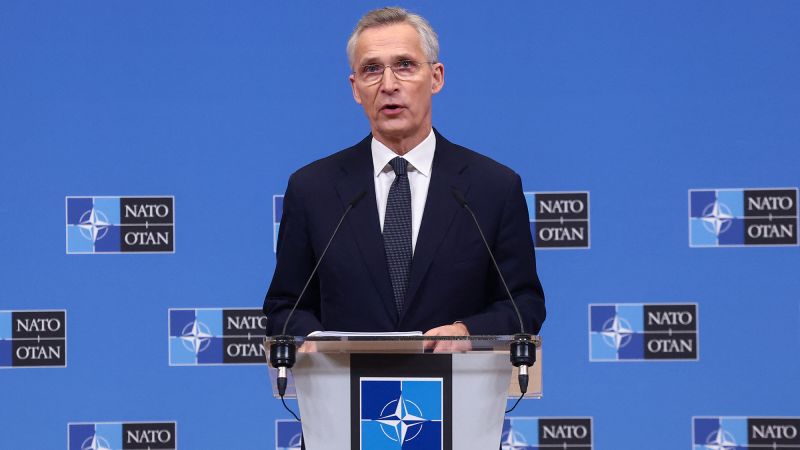February 15, 2024
Breaking Goals: A Record-Breaking 18 NATO States Set to Surpass 2% Defense Spending Threshold
 Record 18 NATO States Expected to Meet 2% Defense Spending Threshold This Year
As threats to global security continue to evolve, it is vital for member states of the North Atlantic Treaty Organization (NATO) to maintain strong defense capabilities. One important measure of a nation's commitment to collective defense is its defense spending as a percentage of its GDP. In recent years, there has been a renewed focus on NATO members meeting the agreed-upon target of allocating at least 2% of their GDP to defense spending. In a significant development, it is predicted that a record 18 NATO states will meet this threshold in the current year.
This milestone achievement marks a significant step towards achieving NATO's goals of a fair burden-sharing and a stronger collective defense posture. The 2% target was first agreed upon during the alliance's Wales Summit in 2014, in response to growing concerns about the increasing security challenges faced by member states.
Over the past decade, there has been a growing disparity among NATO members when it comes to defense spending. Some countries, such as the United States, the United Kingdom, and Greece, have consistently met or exceeded the 2% threshold. However, others have fallen behind, often citing economic constraints as a justification for their lower defense expenditures.
While increasing defense spending can present budgetary challenges for some countries, failing to meet the 2% target can have serious consequences for the alliance as a whole. It undermines the principle of burden-sharing, undermines NATO's credibility, and potentially weakens the collective deterrence capability of the alliance.
The recent rise in defense spending amongst a record number of NATO member states is encouraging. It demonstrates a renewed commitment to collective security and suggests that member countries are taking their defense obligations seriously. The increase in spending also reflects a recognition of the rapidly evolving security environment and the need to adapt and modernize defense capabilities accordingly.
In addition to the symbolic significance of meeting the 2% threshold, the increase in defense spending will have practical implications as well. It will enable NATO members to invest in modernizing their armed forces, acquiring new capabilities, and addressing emerging security challenges. This includes investment in advanced technologies such as cybersecurity, space capabilities, and intelligence gathering, which are critical for maintaining a robust defense posture in the 21st century.
However, it is important to note that meeting the 2% target is just one aspect of the broader effort to strengthen NATO's collective defense. Defense spending should be complemented by other measures such as enhancing military readiness, improving interoperability, investing in research and development, and promoting defense cooperation among member states.
While the progress made towards meeting the 2% threshold is commendable, there is still work to be done. Several NATO member states, including Germany, Canada, and Belgium, continue to fall short of meeting the target. The alliance should continue to encourage these countries to increase their defense spending and work towards achieving the agreed-upon goal.
In conclusion, the fact that a record number of NATO member states are expected to meet the 2% defense spending threshold this year is an encouraging development. It demonstrates a collective determination to strengthen the alliance's defense capabilities and uphold the principles of burden-sharing. However, it is important to ensure that meeting the 2% target is accompanied by other measures to enhance NATO's collective defense, as they are all essential components in maintaining the security and stability of the alliance.
Record 18 NATO States Expected to Meet 2% Defense Spending Threshold This Year
As threats to global security continue to evolve, it is vital for member states of the North Atlantic Treaty Organization (NATO) to maintain strong defense capabilities. One important measure of a nation's commitment to collective defense is its defense spending as a percentage of its GDP. In recent years, there has been a renewed focus on NATO members meeting the agreed-upon target of allocating at least 2% of their GDP to defense spending. In a significant development, it is predicted that a record 18 NATO states will meet this threshold in the current year.
This milestone achievement marks a significant step towards achieving NATO's goals of a fair burden-sharing and a stronger collective defense posture. The 2% target was first agreed upon during the alliance's Wales Summit in 2014, in response to growing concerns about the increasing security challenges faced by member states.
Over the past decade, there has been a growing disparity among NATO members when it comes to defense spending. Some countries, such as the United States, the United Kingdom, and Greece, have consistently met or exceeded the 2% threshold. However, others have fallen behind, often citing economic constraints as a justification for their lower defense expenditures.
While increasing defense spending can present budgetary challenges for some countries, failing to meet the 2% target can have serious consequences for the alliance as a whole. It undermines the principle of burden-sharing, undermines NATO's credibility, and potentially weakens the collective deterrence capability of the alliance.
The recent rise in defense spending amongst a record number of NATO member states is encouraging. It demonstrates a renewed commitment to collective security and suggests that member countries are taking their defense obligations seriously. The increase in spending also reflects a recognition of the rapidly evolving security environment and the need to adapt and modernize defense capabilities accordingly.
In addition to the symbolic significance of meeting the 2% threshold, the increase in defense spending will have practical implications as well. It will enable NATO members to invest in modernizing their armed forces, acquiring new capabilities, and addressing emerging security challenges. This includes investment in advanced technologies such as cybersecurity, space capabilities, and intelligence gathering, which are critical for maintaining a robust defense posture in the 21st century.
However, it is important to note that meeting the 2% target is just one aspect of the broader effort to strengthen NATO's collective defense. Defense spending should be complemented by other measures such as enhancing military readiness, improving interoperability, investing in research and development, and promoting defense cooperation among member states.
While the progress made towards meeting the 2% threshold is commendable, there is still work to be done. Several NATO member states, including Germany, Canada, and Belgium, continue to fall short of meeting the target. The alliance should continue to encourage these countries to increase their defense spending and work towards achieving the agreed-upon goal.
In conclusion, the fact that a record number of NATO member states are expected to meet the 2% defense spending threshold this year is an encouraging development. It demonstrates a collective determination to strengthen the alliance's defense capabilities and uphold the principles of burden-sharing. However, it is important to ensure that meeting the 2% target is accompanied by other measures to enhance NATO's collective defense, as they are all essential components in maintaining the security and stability of the alliance.
If you would like to delve into the world of investment topics , go to our partner project Wall Street Wizardry


